News
STA, 6 March 2019 - The government managed to get the revised budget for 2019 through parliament on Thursday with the help of the opposition Left. But the vote does not end uncertainty over this year's spending, as the upper chamber has indicated a veto was possible and the Left may make its support in a re-vote conditional on additional spending.
The supplementary budget sets expenditure at EUR 10.16bn, a rise of EUR 463m or 4.8% from the original budget. Revenue is to go up even more, by 6.2% or EUR 599m to EUR 10.35bn, exceeding EUR 10bn-mark for the first time, mostly due to significantly higher public sector wages.
The adjustments increase funding for almost all ministries despite warnings from the centre-right opposition and the Fiscal Council that such spending hikes risked setting up Slovenia for trouble now that economic growth had started to cool down.
The government has rejected criticism with the argument that the spending blueprint was treading a middle path between exclusive focus on welfare and excessive austerity. It insists the budget is fiscally sustainable.
The budget was passed without the support of the opposition Democrats (SDS) and New Slovenia (NSi). The former argued that the government had ignored warnings of the Fiscal Council, while the latter was bothered by the rejection of the amendments filed by the SDS, NSi and the National Party (SNS).
The three opposition parties had filed 34 amendments, mainly concerning the funding of infrastructural projects, but all of them were rejected.
But the SNS nevertheless supported the budget. According to party head Zmago Jelinčič, this was only to see how the European Commission will respond.
To secure passage, the government has had to reach a deal with the Left that entails additional spending potentially running into several hundred million euro on policies including precarious work forms, housing, corporate tax, wages, pensions and healthcare.
The initial plan was that the pact would be signed before today's vote, but due to apprehension by some coalition partners, in particular the Social Democrats (SD) and the Modern Centre Party (SMC), it was merely initialled after a half-hour recess in which the final details were hammered out.
The leader of the Left, Luka Mesec, said the deal was very similar to the one that was initialled with the government last summer. He expects it to be signed in the coming days.
In line with the deal, the leader and the secretary of the Left will from now on be invited to the meetings of coalition deputy groups every Tuesday.
The head of the deputy group of the ruling Marjan Šarec Party (LMŠ), Brane Golubović, rejected criticism that the agreement had not been coordinated with other coalition parties, saying that all ministries concerned had participated in the talks, including those led by ministers of the SMC and SD.
There has been some speculation that the pact with the Left may be sidelined after the budget is confirmed, but this would leave the budget vulnerable in the event of an upper chamber veto, which is possible given the balance of power in the chamber.
The National Council recently denied support to the budget, with councillors voicing complaints about government plans in the area of local government and regional development.
Any vetoed legislation would requires confirmation by 46 MPs in the 90-member National Assembly. The coalition only has 43 votes.
Prime Minister Marjan Šarec said he was not surprised by the threat of the veto. "I only hope to hear some solid arguments, because the ones I heard today are very shaky considering the wishes of those presenting them and are reminiscent of horse-trading," the PM said.
https://www.total-slovenia-news.com/travel/3147-gay-slovenia-ranked-28-for-lgbt-travellers-highest-in-ex-yugo
Yesterday, March 6, saw the official start of the Red Dawns International Feminist & Queer Festival, which offers several days of events, exhibitions, discussions and concerts to bring people together for art and activism. The full programme for the event, in English, can be found here, while the Facebook page is here.
One large event, not strictly part of the festival but surely related, will be the Women’s Day march that’ll take place on Friday (08/03), starting at 17:00 in Congress Square (Kongresni trg), the main square downtown that’s also home to Zvezda Park.
All our stories about LGBT+ issues and Slovenia can be found here
Below is a review of the headlines in Slovenian dailies for Thursday, 07 March 2019, as summarised by the STA:
Economy
"Layoffs already taking place because of cool-off in Germany": The Slovenj Gradec-based company Dani AFC is facing a decline in orders from Germany for car seat covers for Audi models, and is forced to lay off 60 workers. (front page, 8)
Budget
"Supplementary budget passed, unease remains": The National Assembly passed yesterday the supplementary budget for 2019, keeping together the minority coalition, which nevertheless remains uneasy as new allegations are piling up. (front page, 2)
Science
"How life works": Slovenian scientist Jure Leskovec is heading a team at Stanford University who is looking into strategies of survival common to all organisms in the world by analysing complex protein networks by means of supercomputers. (front page, 13)
DNEVNIK
Buildings
"Dangerous buildings could be supported by Brussels money": The state needs to take the opportunity if the EU endorses expensive measures to improve earthquake resistance of problematic buildings in the next financial perspective. (front page, 10)
Pay system
"Employer organisations appalled by GZS's proposal": A reform of the pay system in the corporate sector proposed by the Chamber of Commerce and Industry (GZS) is facing opposition from other employer associations, both because they were not involved in the process and because some proposals sound like they come from trade unions. (front page, 5)
FINANCE
Takeovers
"How good bids for Intereuropa really are": The paper analyses the three binding bids for the Koper-based logistics company Intereuropa, noting that it will be known by the beginning of April to whom and for how much it will be sold. (front page, 10-11)
Economic trends
"OECD significantly downgrades forecasts, Italy in recession this year too?": The Organisation for Economic Co-operation and Development (OECD) has downgraded its GDP growth forecasts for almost all major economies in the world. (front page, 2-3)
Pension reform
"Five facts about pensions and demographics": The number of pensioners is growing, the majority of old-age pensions equals minimum wage, the ratio between employers and pensioners has improved somewhat, but ageing decreases the number of working-age people and public spending for pensions will only get higher. (front page, 6-7)
VEČER
Internet scams
"A click away from internet mafia": Con artists on the internet are successfully preying on women who fall for fake doctors or soldiers, and on men who are looking for sexy young women. Victims of such scams are often silent. (front page, 5)
Budget
"Budget passed, dispute resolved": The National Assembly passed yesterday the supplementary budget for 2019 as the minority coalition and the opposition Left had signed a cooperation agreement for this year despite a dispute. (front page, 2-3)
Šiško trial
"Lining up ahead of Andrej Šiško's trial": Supporters of Andrej Šiško, who presented his case yesterday as his trial started over the formation of a para-military group, lined up in front of the Maribor court and brought a masked man with a limousine, who represented the "erased Slovenian people". (front page, 2-3)
Mercator
"Decisive days for Mercator": Decisive days are coming for Slovenia's largest retailer Mercator, as it is planned to be transferred from the indebted Croatian conglomerate Agrokor to the newly-formed company Fortenova Grupa, seated in the Netherlands. (front page, 6)
A leisurely walk in the woods in many countries, especially in my home country of England, invokes an image not only of peace and tranquillity, but also one of relative ease and safety. One of the advantages of the UK is that nothing really dangerous lurks in our woods; other than the odd crazy person with an axe or a gun. In Slovenia however, while you are less likely to encounter an axe-wielding homicidal maniac, there are other more natural dangers to be aware of: bears!
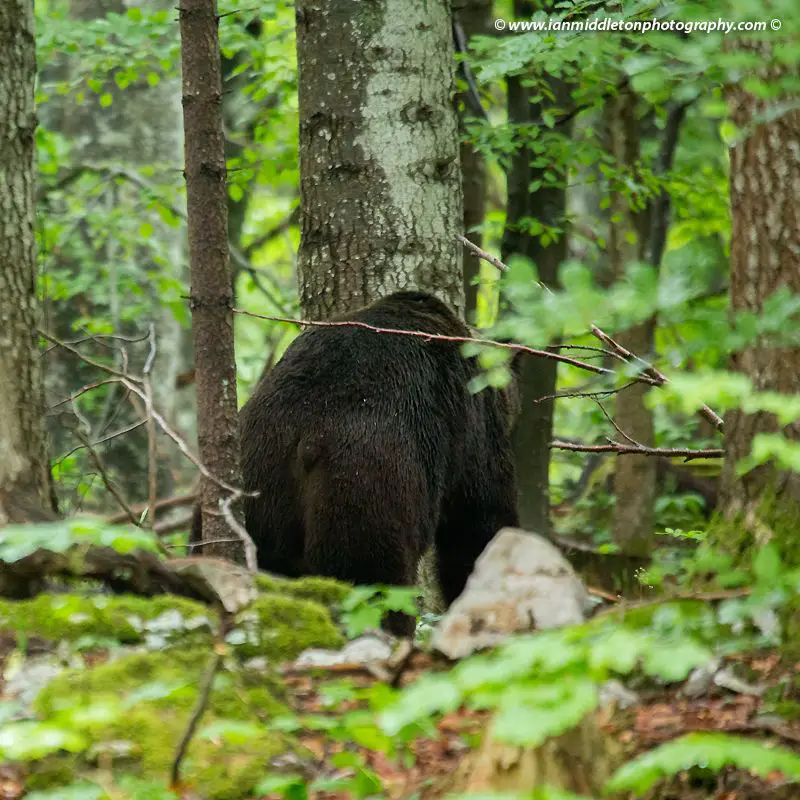
Brown Bear in the forest in Notranjska, Slovenia.
If you go down to the woods today, the likelihood that you’ll encounter a bear is extremely low. Over the years I have frequently gone driving and walking in areas where I had hoped to see or photograph them. Not a single sighting. Yet there is an estimated 800-900 European Brown Bears in Slovenia, bearing in mind (pun intended) that many of these bears and other wildlife routinely wander between Slovenia and Croatia. The brown bear is an elusive creature and at best it’s safer to go with a hunter, or an organised tour.
A few years back I did manage to find someone who had setup a series of hides specifically designed for photographers, so I was able to finally go on a bear watch and capture some great photos. However, while these are ideal for serious amateur or professional photographers, they are not so good for tourists who simply want to see the bears but don’t have the expensive camera equipment required to photograph them.
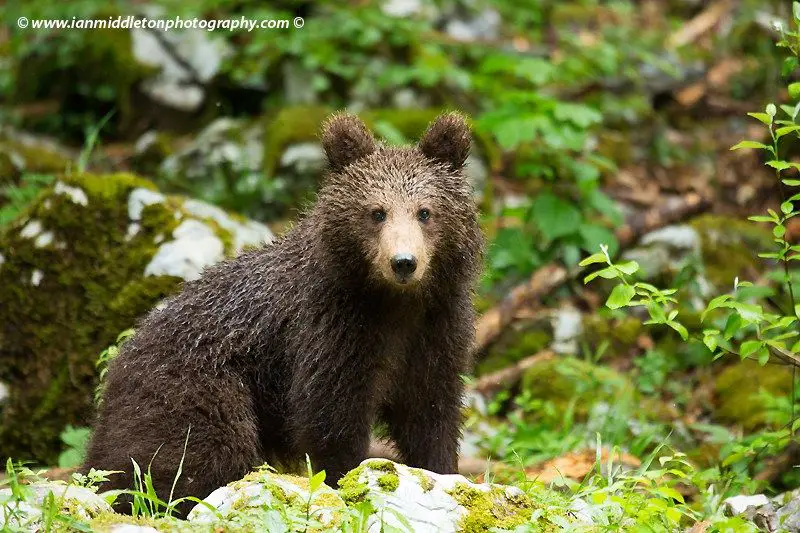
A one year old Brown Bear Cub in the forest in Notranjska, Slovenia.
So imagine my delight when I found Bears and Wildlife Tours. Based at the tourist office in the little village of Hrib, in the municipality of Loški Potok, they offer an array of wildlife watching tours as well as bear viewing huts. But the most intriguing of all, was the offer of staying the night in a simulated bear cave. I had to go and see.
The journey took me south from the capital Ljubljana to the border with Croatia, where I met with Tjaša, who organises and coordinates the tours, and Stanko, a local hunter and guide. We were already late into September so they told me that the chances of a sighting were low because the bears usually come out late in the evening, and as the sun is now setting earlier it would more than likely be dark by this time. But they would take me to see what they had to offer anyway.
Over a strong cappuccino, they told me a little about the bears and what they offer. They currently have about 7 hides in total, 3 in the Loški Potok region. This gives them much more scope to ensure a sighting for their guests. “We have never seen the same bear at each of our hides. The bears travel around 60kms per night or day. Many go from Loški Potok to Cerknica, and of course across the border,” said Tjaša.
The bears tend to travel over a specific area. A mother bear can remember from 5 years before where she got a good meal. Amazing, I struggle to remember where I ate yesterday!
Their numbers are increasing. In 1960 there was an estimated 150 bears in Slovenia. In 2018 that number was around 900. These numbers apparently swelled during the Balkan conflict; where many bears I guess fled here for asylum! I asked how it’s possible to know the numbers. “Hunters collect bear poo and send it to Ljubljana to the institute and from the DNA they can estimate their numbers. Every year the number is increasing,” replied Tjaša.
Mother bears in Slovenia are now giving birth to 3 cubs instead of 2. Rarely before have bears had more than 2. This is also an indicator that the quality of their habitat and food source is improving. 2018 was a particularly good year for food, as conditions that year made not only the forest rich with food, but the village orchards were overgrown with fruit. Stanko explained to me how September 2018 has seen an unusual rise in bears coming into the villages, much more than previous years. In autumn the bears are fattening up for the winter hibernation.
The improved quality of the habitat is partly down to conservation work, and rules being enforced that prevent hunters or bear tour organisations from feeding the bears within 2kms of a village. This helps stop them from wandering into villages in search of food and prevents any incidents with locals, and also accidents with cars. One of the biggest threats to bears is being hit by cars.
Every year the government sets an annual cull to try to control the population. For 2019 it was 200, increased from previous years because of the reasons above. However, this decision was suspended by the administrative court after a case was brought by the environmental protection organisation Alpe Adria Green (AAG).
A Winter Den and Bear Jacuzzi
After coffee we headed out for the first part of the tour. Stanko drove us to a location a few kilometres outside of town, where we stopped beside a forest road. He pointed to the forest and said that just up the hill is a winter den for a mother bear.
Bear dens are always close to water, so they can often be close to the road and village. Stanko and Tjaša then pointed to a stream running out of the forest to the roadside and told me how the bears will seek out sources of water, especially when it’s very hot.
These pools of water or streams are mostly deep in the forest well away from people and villages. However, they are also found on roadsides like this close to villages, because the water that runs off the forested hillsides collects in pools by the road. Stanko regularly comes here deer hunting and told me how, early one morning around 5am, he spotted a bear immersed in a pool of water up to its neck, with just its head poking out the surface.
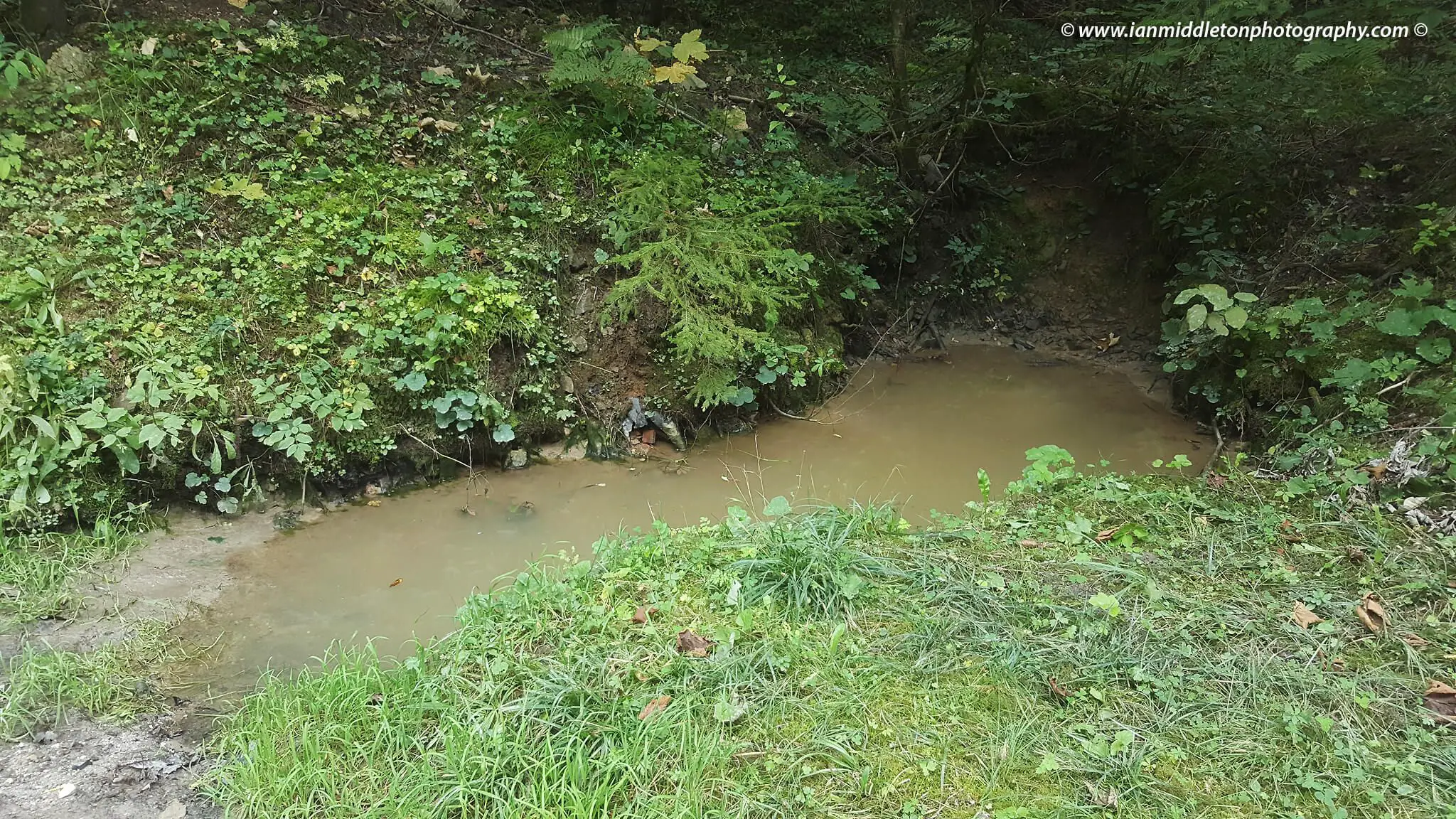
“I call it the Bear Jacuzzi”, he laughed.
The bears often come to these roadside pools to cool off in the heat of the summer days, and Stanko, and likely many locals, see them as they drive these forest roads.
Mushrooms – A national sport
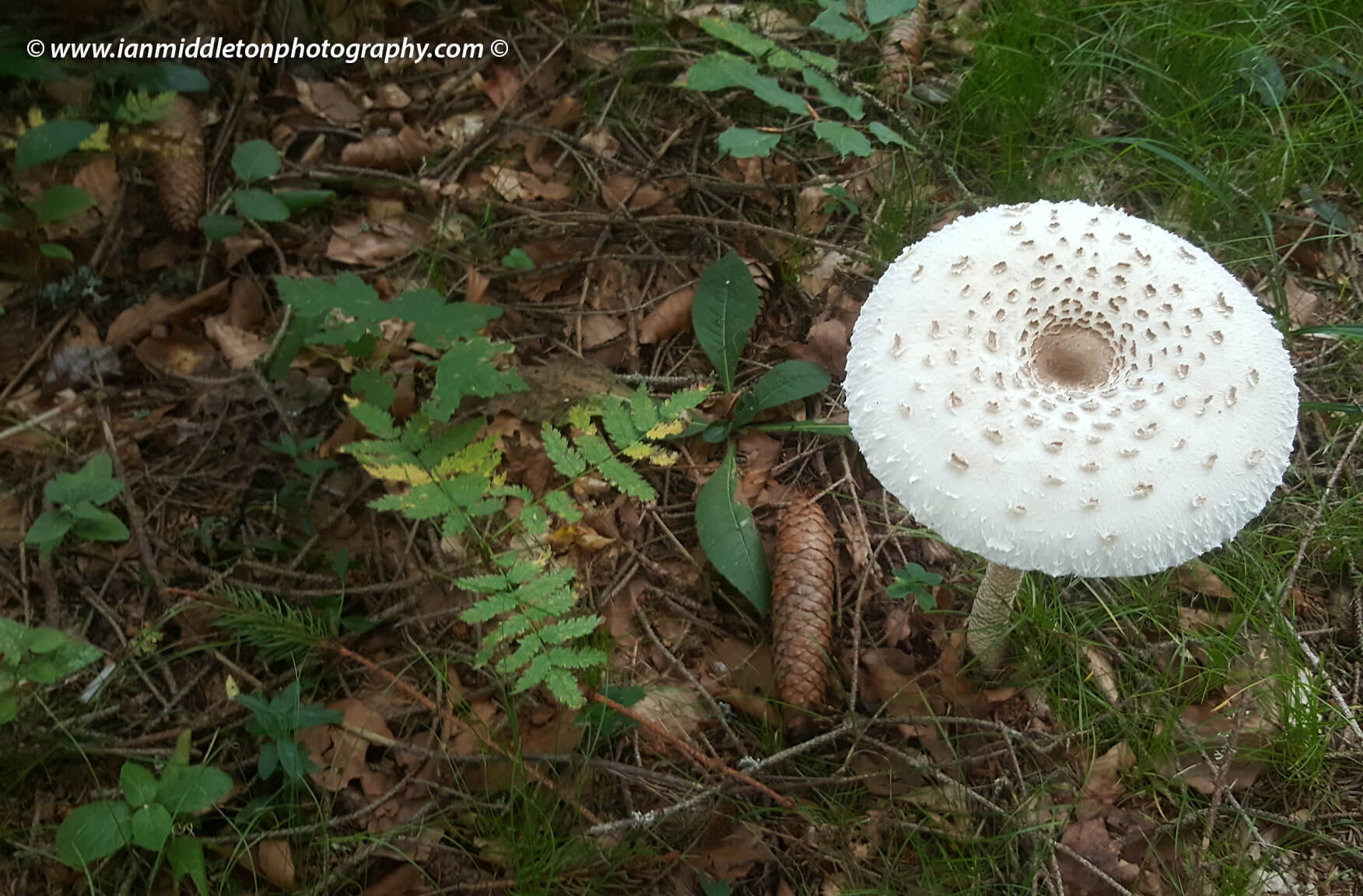
Wild Parasol mushrooms, known as Marela in Slovenia.. Macrolepiota procera or Lepiota procera
I then followed them up the hill to the winter den. On the way Tjaša picked some mushrooms and described how to prepare them. Mushroom picking, along with other forest fruits, is a national sport here in Slovenia. Every season the forests are packed with locals out mushroom picking, and they are usually racing each other to get the best and most. She also explained how to tell the difference between a poisonous and non-poisonous one.
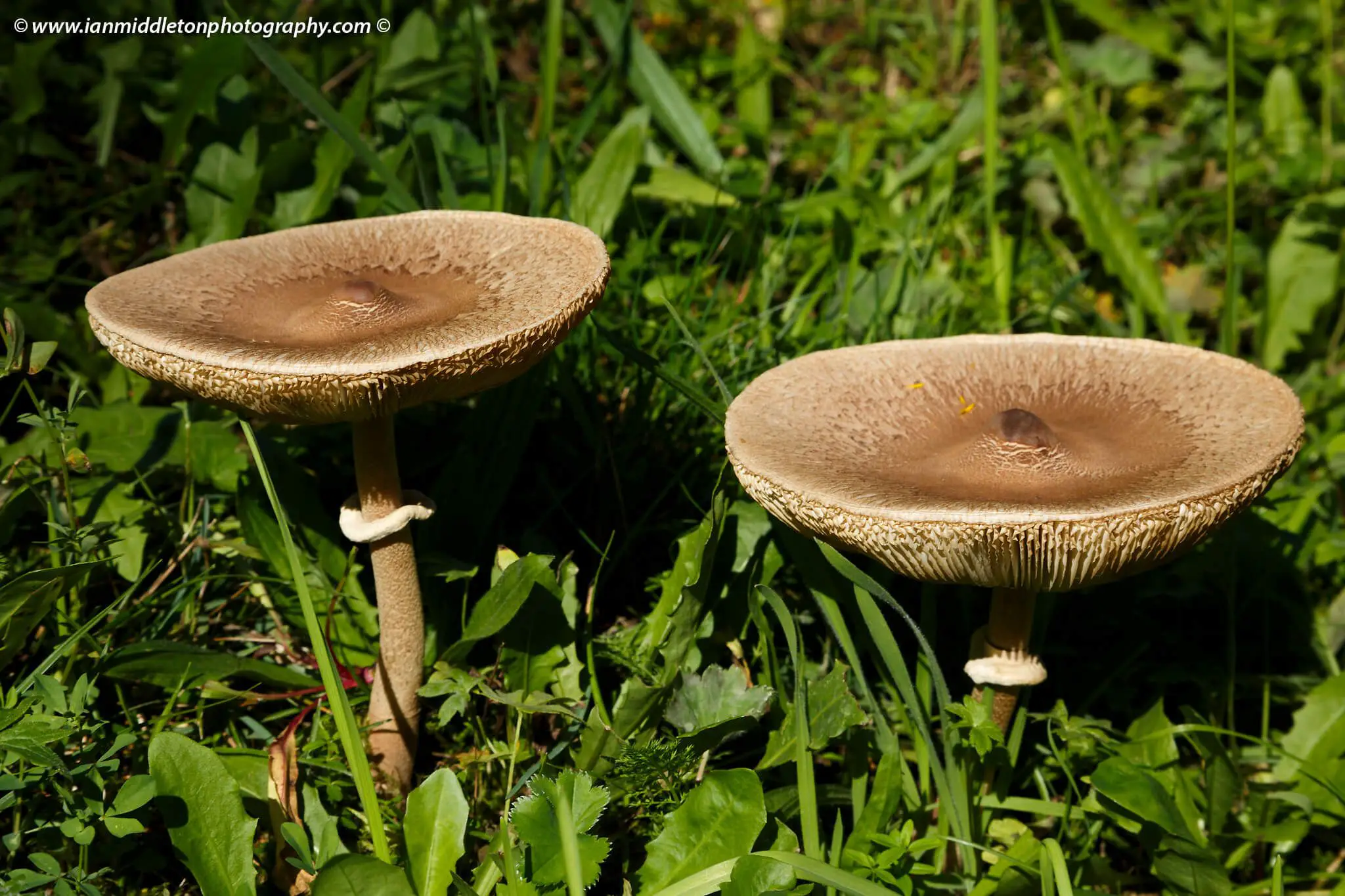
Wild Parasol mushrooms, known as Marela in Slovenia. As you can see, on the stem this circular piece is an indication that the mushroom is non-poisonous.
“I’ll take these to my mother in law’s tomorrow for cooking,” I said.
I feel I should add here that I fully intended to give my mother in law the non-poisonous mushrooms.
Slovenian folklore says that if you see a mushroom in the forest you must pick it immediately, no matter how big or small it is. Once someone has seen it, the mushroom will stop growing. Tjaša also explained that when you pick a mushroom you must clean it there and then in the forest before you take it away.
The bear cave
Bears hibernate during the winter in a den, essentially a small cave deep in a hillside. The entrance is narrow, but inside it is very wide and deep. The bear can get inside because its head and neck are very small and it doesn’t have a collar bone, so can squeeze its body through.
The bears enter the den when the first snow comes, or before if it’s a pregnant female. She will give birth in January and emerge from the den in April with her cubs. The cubs remain with the mother for two years. Therefore the bear has cubs every three years.
The male bear typically weighs 300kgs, while the female weighs 150kgs, so they can tell by the small size of the den that this is for a female only.
Responsible tourism
Bears and Wildlife Tours believe in keeping tourism to a minimum. Therefore they don’t have tours every day in the same location, so the wildlife isn’t disturbed too much. Bears can smell fresh blood from up to 4 kilometres away, and have excellent hearing too. If too many people are around the bears will hear and keep well away. Unless you are hunting!
On the way to our next destination, the viewing cave, Stanko told me a story about a time he shot a roe deer. Afterwards he placed his rifle against a tree and proceeded to cut open the deer and gut it. When he had finished pulling everything out, he took the gutted deer to his vehicle about 400 metres away.
Upon his return, Stanko got to within 100 metres to discover that between him and his rifle was a big male bear feasting on the leftover deer. It was not the most ideal of circumstances, so Stanko had no choice but to patiently wait before he could retrieve his firearm.
So to not only ensure the safety of visitors, but also ensure they don’t scare away the bears and other wildlife, they practice responsible tourism and ensure the numbers are kept low, and wildlife tours are conducted in different places each time.
There are very strict rules governing hunters and tourist organisations offering wildlife tours or trips to see bears in Slovenia. Along with the 2km rule, it is forbidden to feed the bears with farmed meat. But when gutting a deer it’s permitted to leave the leftovers in the forest for the bears to find, as long as they don’t find you first! But while an attack is undoubtedly terrible for the victim, it also means a death sentence for the bear. Once a bear has attacked a human being, it will be hunted down and killed. So these rules are not only there to protect people, but to protect the bears too.
Despite its love for meat, bears are actually 90% vegetarian. A sobering thought when you are just about to trudge through bear country.
Off to the bear viewing cave
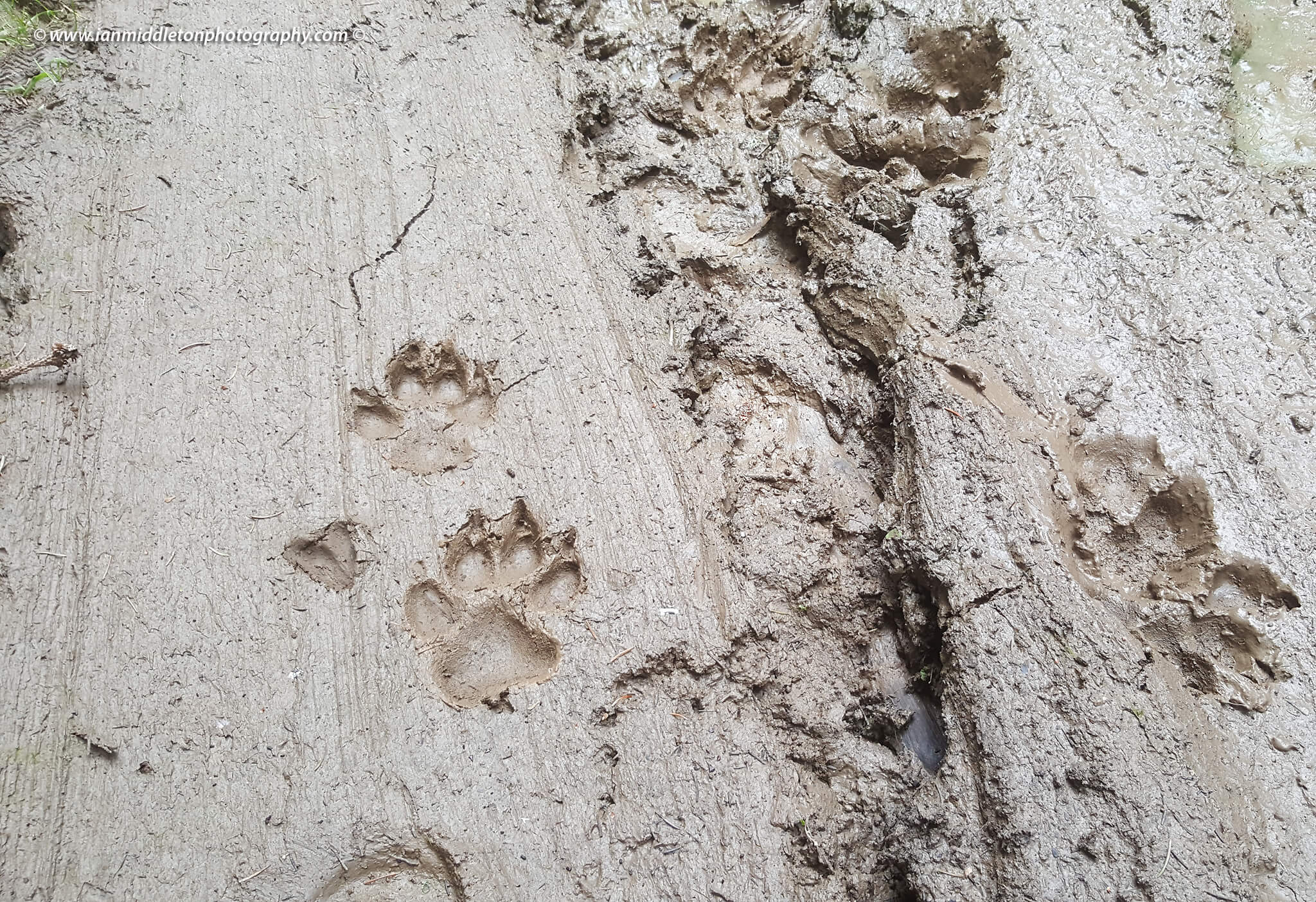
Wolf footprints in a forest in Loski Potok, Slovenia
We then headed off to the starting point of our walk deep into the forest to one of their viewing huts and, in this case, the bear viewing cave which you can sleep in. Along the way we spotted some wolf tracks, apparently attracted here because it’s deer mating season. As we got deeper into the woods I was told that from here on we must be very quiet and talk in whispers, or else the bears will sense us. In our case, we were here to spot them, so didn’t want to scare them off.
I just hoped the big bucket of apples that Tjaša was carrying wouldn’t encourage them to overcome their fear of humans!
What to do if you encounter a bear
Contrary to popular belief, bears are not the man-eating beasts they can often be portrayed as. In fact, they are very nervous creatures and will likely hear you first and keep well away. Attacks are usually the result of a bear being startled by a walker, or often a bird watcher who is not making any noise; or a photographer sneaking around to take photos. The bear will only attack if it sees no means of escape. Or if you inadvertently come between a mother and her cubs, you’re in for trouble.
Ordinarily when walking in the woods the advice is to never walk alone, and walk and talk (but don’t shout), make as much noise as possible in order to stay safe and avoid startling a bear, or other wild animal. This way the bear will hear you first.
There are many stories about what to do if you happen to surprise a bear. Although the instinct is to run, this is apparently the worst thing to do. A bear can run much faster than you, and if you run it will see you as a threat. Some say you should grab a stick and make yourself look big and loud. If the bear charges at you, remain still. Chances are it is a bluff and will veer away at the last minute.
Another crazy theory I heard is that you should run downhill, because the bear’s front legs are shorter and it cannot run fast downhill. But Tjaša laughed and said that the bear will still outrun you.
Tjaša’s advice is simple: back away slowly, always keeping your eye on the bear and it will very likely run away from you.
The Bear Cave
When we arrived at the viewing spot, a wide open meadow at the edge of the forest, Stanko went off alone first to check it was safe. Then they both prepared the food they would put out to try and attract the bears; Tjaša didn’t touch the food to ensure any human scent was kept to a minimum. For obvious reasons, the area was a short distance away from the viewing area. Tjaša explained that, for the reasons above, Stanko alone must go; no one else, not even her.
This particular viewing area is actually right beside the Croatian border. There are two places from which to observe the bears. The first is a viewing hut setup for both photographers and casual observers. The second is the specially designed bear cave. Here they have built a small wooden room into the rocks that is designed to simulate a bear’s den. Inside I was surprised to discover a cosy double bed and a row of seats next to small windows that look right out across the field to where the bears will hopefully come.
Stanko returned with a special night vision camera that they clamp to a tree where the bears are. It is triggered by movement so they can see when they are active at night. The previous night they came at 9pm, after dark. This was not looking promising for me. But as they had explained I was well into September now so the chances of a sighting during daylight were much lower.
The camera also showed a bear was here at 8.30 in the morning. So this goes to show that a night in this bear cave will undoubtedly increase your chances of a sighting. Sadly, commitments elsewhere meant I couldn’t stay the night.
The best time to take this tour is in high summer, from late May through June and July. August is also a possibility. The tours start at 16:00 and end at 22:00. There are several observation points like this, all on hills in areas of wide open space with lots of light.
But there is only one bear cave, and in this case you get to spend the night here. Naturally this increases your chances of a sighting, because you can also wake early and likely see them in the early morning.
Soon after, Tjaša and Stanko left. Just before he bolted the door, Stanko looked at me and said: “Do not go outside.”
I had no intention of doing that.
I was alone. All was quiet. I settled down for the evening, camera ready. When I had been on the photography tour a few years before we were extremely lucky that, not more than 30 minutes after settling into the observation hut, a couple of one-year old cubs came, followed by the mother and soon after a big male.
As the time ticked away I continued to live in hope. A bird of prey was swooping by occasionally, but sadly no bears.
Stanko returned to collect me after dark, and we trudged on through the forest without torches back to the car. Along the way he told me how he had been privileged to see a lynx in the forest. The Eurasian Lynx was reintroduced to Slovenia in 1973 by a hunter’s initiative. The current population is estimated at about 15-20. Thus not only are their numbers low, but they are very shy animals so a sighting is extremely rare. He showed me a photo he had. “It was a big privilege for me,” he said, proudly.
The love and respect that both Stanko and Tjaša have for the bears and other wildlife is clearly evident.
All this just goes to show how difficult it can be to spot the wildlife, and how important it is to go with an organisation like Bears and Wildlife Tours. Not only will they ensure your safety, as long as you follow their rules and instructions to the letter, but it will increase the chance that you too will be privileged enough to see one of these magnificent animals in their own habitat.
I had seen them before, but sadly not this time. However, I plan to return in May or June for another tour, and maybe even an overnight stay in a bear cave!
How to go
If you would like see bears, then visit the Bears and Wildlife Tours website. They also offer other wildlife tours, including as well as the bear cave, the opportunity to sleep on a rocky shelf in the forest and experience the sights and sounds of nature, with your guide there to keep you safe.
More info and bookings here: www.bearsandwildlife.si
Check out a video of the trip below:
For a more comprehensive look at Ian’s photography, check out his free e-book here. You can see many images in higher resolution, find other photo posts and subscribe to his newsletter here.
STA, 6 March 2019 - Archbishop of Ljubljana Stanislav Zore has argued for the weekly paper Družina that sexual abuse within the Catholic Church is not a systemic problem. While underlining efforts to secure as much protection for minors as possible, he said the Church was part of human society "with all its flaws".
Zore said that "we will never reach a point where there will be no more mistakes, when there won't be a single case of abuse".
He argued that "we remain a human society, the Church and society in general, with all its flaws. "Then it would probably be necessary to root out people as such. And this is not possible."
The Church is however striving "to reach the highest possible level of protection for minors and everybody else within the Church and society at large".
Echoing the recent statements of Pope Francis, Zore said that the Church is not at point zero when it comes to efforts to tackle sexual abuse, with "some Bishops Conferences starting on this path already in the previous century".
"In Slovenia too, we've had the first guidelines since 2006 which we've been upgrading until last year," he said, announcing additional upgrades when necessary.
He meanwhile believes the discussion should give more focus to prevention, meaning education. Listing possible measures, he mentioned caution when selecting candidates for theology studies and thorough checks after the studies.
As to his conviction that sexual abuse within the Church is not a systemic issue, he spoke of "rotten apples among many healthy ones, although this does not reduce their responsibility or the responsibility of the Church".
"In Boston, an example of tackling sexual abuse, the share of perpetrators among all priests in the period for which cases of sexual abuse were handled was 2%. In Philadelphia the share was 1.4%, in Chicago 1.8%," Zore said.
He dismissed those arguing the Church no longer had the right to preach the gospel, saying that although most cases of paedophilia occurred within families, he did not preconceive of parents in general as paedophiles.
"Nobody is without sin. But being a sinner should not mean you giving up your calling as a mother, father. Follow this calling, because it is yours. In the same way, preaching the gospel remains the calling of the Church."
STA, 6 March 2019 - Mercator needs to be excluded from the indebted Agrokor group and transferred to the new Fortenova Grupa as soon as possible, Agrokor's crisis manager Fabris Peruško has told the STA in an interview. The process has its own dynamics, he said, adding that it could be completed by the end of the year.
Peruško has been responsible for the winding down of Agrokor since February 2018, he will also head the new Fortenova Grupa which will be launched on 1 April to bring under one hat Agrokor's successful subsidiaries.
Meanwhile, the insolvent companies will remain part of Agrokor. The process of transformation will start with Agrokor's companies in Croatia, while those based in other countries will be included once the process is completed in Croatia.
On 1 April, 32 solvent Croatian companies will become part of the new group, while the 45 Croatia-based insolvent companies, which will remain part of Agrokor, will each get their own "mirror company", which will also be included in the Fortenova Grupa.
The names of the new companies will be made up using their original names and the word plus, said Peruško.
The third group of companies includes Croatia-based companies in which Agrokor holds less than 25% and 82 Agrokor companies based in Slovenia, Serbia and Bosnia-Herzegovina.
"Mercator is in the third group and we want a speedy transfer of assets from the company in receivership, Agrokor, to the more health company, Fortenova. This is also important for Mercator's suppliers, employees and the entire Slovenian economy."
Peruško expressed satisfaction with "fair relations" between Agrokor and Slovenia's Economic Development and Technology Minister Zdravko Počivalšek, as well as with Gregor Planteu, a government-appointed member of Mercator's board.
He believes that it would be advantageous if Planteu remained on the board of Mercator also after the retailer becomes a part of Fortenova Grupa. The transfer of Mercator to Fortenova does have its own dynamics which depends on the Slovenian legislation.
"Certain small Slovenian banks have reservations about the transfer but I believe that the plan contains rational economic arguments and that it must be green-lit as soon as possible because this is in the interest of the banks."
"If the banks fail to support the transfer, Mercator will remain a part of a company that has gone bankrupt. This is in nobody's interest," Peruško said when asked about the potential scenarios for Mercator's future.
The most imminent steps for the plan to be implemented is to get the go-ahead of the Slovenian competition watchdog and resolve issues involving minority shareholders, both of which Peruško sees as mere formalities, which do, however, take a certain amount of time.
When asked whether Mercator could become one of the leading companies of Fortenova Grupa, Peruško said that Mercator, as well as Croatian retailer Konzum, must be viewed in the scope of the group's entire retail division.
Both companies are facing challenges in different markets of the region. Their operations must be optimised to the benefit of the entire group. Peruško underlined that synergies of the two groups must finally become reality.
Peruško, who was not involved in Agrokor's takeover of Mercator in 2014, believes that the Croatian group paid a lot for Mercator. He also said that Mercator was in better condition now than it was before the takeover.
"When it was taken over by overindebted Agrokor, Mercator was not a healthy company and Agrokor provided a much-needed injection that helped it survive."
"The problems started when they failed to build a platform that would make them healthy partners for their suppliers." Peruško said that Fortenova Grupa would abolish certain limitations to allow better partnerships with suppliers.
The Agrokor boss believes that the Slovenian market is too small for Mercator. "I see Fortenova Grupa as a new and healthy platform on which Slovenian suppliers will be able to develop their business."
Fortenova Grupa will start out with a lot of debt: between EUR 1.4bn and EUR 1.5bn. The group expects to generate between EUR 320m and EUR 340m in operating profit. It will moreover sell off business operations that are not a part of its core divisions: retail, food production and agriculture.
STA, 5 March - The women's magazine Onaplus has picked lawyer and lecturer Sara Ahlin Doljak as the winner among twelve inspirational Slovenian women whose professional achievements defined the past year and who led by example.
Ahlin Doljak, diagnosed with multiple sclerosis, has not let her disability be an obstacle to success, the judging panel said in awarding Doljak the title Ona 365 (She 365) for 2018.
Speaking through a speech generator device Tobii, Doljak shares important professional as well as personal insights and her voice deserves to be heard by everyone, the jurors said. Doljak lectures at the European Law Faculty in Ljubljana and Nova Gorica.
"She incidentally makes us ponder - who are we and most importantly, what we could be. Despite the challenges life imposes on her, she thrives. Each time she stresses how large life is and her esteem for it. And that family is everything," said Onaplus editor-in-chief Sabina Obolnar.
"She doesn't conceal bitter moments and self-reflections. And one day she realized that she learned everything besides living," Obolnar added at Tuesday's award ceremony in Ljubljana, which also marked the 25th anniversary of the magazine.
Obolnar also pointed out that all twelve nominees are exceptional and successful women who honour life and despite being less visible in the media, leave a great legacy behind.
The 12 nominees for the title included successful surgeon Saba Battelino, who managed to restore hearing of a five-year-old, the first blind translator from Norwegian to Slovene Irena Mihelj, successful journalist, presenter, and author Mojca Širok, and ski star Ilka Štuhec.
Prime Minister Marjan Šarec was also present at the ceremony and congratulated the nominees.
STA, 5 March 2019 - Ivo Štandeker, a Slovenian journalist killed while reporting from besieged Sarajevo at the start of the war in Bosnia in 1992, will be posthumously honoured by the city of Sarajevo with the Citation of the City of Sarajevo.
The Citation is conferred on Bosnian or foreign citizens, companies and organisations for their contribution to Sarajevo's development in a number of fields.
Štandeker is considered one of the finest and most critical Slovenian reporters from the 1990s.
He was wounded during the Serb shelling of the Sarajevo borough of Dobrinja on 16 June 1992 and died a few hours later in a hospital in Pale.
Also wounded alongside Štandeker was US photojournalist Jane Schneider, with whom he had wanted to get to a spot from where they could take photos of a nearby hill where the Serb troops were stationed.
A decision to honour Štandeker (1961-1992), war correspondent for the magazine Mladina, has been taken by the city council, a Slovenian association from Sarajevo said on its Facebook page.
A memorial plaque to Štandeker was unveiled at the site where he was wounded in 1997, and he was also posthumously honoured in 1992 with the Order of Freedom, the highest state decoration in Slovenia.
The Slovenian Cultural Society Cankar in Sarajevo said that in his reports from the besieged city, Štandeker sympathised with the locals.
It quoted his statement "I love cities and I hate it if they get attacked", which is inscribed on the memorial plaque.
During the 1990s wars in the former Yugoslavia, Štandeker also reported from the besieged Croatian cities of Vukovar and Dubrovnik.
The screenshot at the top of this story comes from this Slovenian video
STA, 5 March 2019 - Slovenian chief financial officers (CFOs) expect a somewhat less positive outlook of the state of the economy this year, and point to operational cost management and lack of trained workers as the main risks to business, according to the 2019 survey by consultancy services provider Deloitte Slovenija.
"The main findings of the survey, which has been carried out for the 10th time in Central Europe and for the 8th time in Slovenia, are that CFOs expect growth to slow down.
"In Slovenia, they stressed that an unstable fiscal or legislative environment in general makes their business highly uncertain," Deloitte Slovenija director Barbara Žibret Kralj said as she presented the survey in Ljubljana on Tuesday.
With the minimum wage to rise in Slovenia, Slovenian CFOs expect labour costs to rise the most among all costs. And just like in 2018, they point to hiring adequately trained staff as one of the biggest problems.
The CFOs also expect the unemployment rate to rise, and see banks as the most popular lenders, with internal sources of funding also playing an important role.
Mojca Osolnik Videmšek from the Gorenjska Banka bank said the economy was deeply in an investment cycle, so the need for banks as sources of funds, also because of low interest rates, was there to stay.
This year's survey also focused on artificial intelligence.
More than three-quarters of CFOs in Central Europe and around 40% in Slovenia say their companies lack the support of artificial intelligence in decision-making processes.
In Slovenia, two-thirds of companies say artificial intelligence is important for the development of financial services, but are poorly prepared for implementation.
Slovenian CFOs also believe artificial intelligence will create many jobs in the medium term, but a quarter maintain it will make many jobs obsolete in the long run.
While firms compete globally to attract IT experts, Juri Sidorovič from Deloitte said directors not giving clear instructions and not setting goals was sometimes a problem.
"The problem is what a goal is, what we want, what can be modernised, what can be robotised," he stressed.
Deloitte Slovenija also commented on the tax reform presented last week, with Andreja Škofič Klanjšček saying it was more of a "correction since it brings no major changes".
She welcomed the planned changes to personal income tax to finally take the pressure off of those in the middle of the income scale, and exempting holiday allowance from all taxes.
However, Škofič Klanjšček is worried about the planned rise in corporate income tax from 19% to 22% and about the minimum taxation of 5% of all legal entities.
The participants of the news conference said raising the corporate income tax "is a bad signal to attract investors".
They also complained about the lack of a strategy in which the government would set goals to be achieved with tax changes.
Sidorovič said the state could for instance decided to promote IT and then take measures to implement such a strategy.
Below is a review of the headlines in Slovenian dailies for Wednesday, 06 March 2019, as summarised by the STA:
Taxes
"New taxes": Even before the new tax package is adopted, questions are being raised about whether it will achieve the desired effects. And even though Finance Minister Andrej Bertoncelj calls it tax reform, is it really? (front page, 8)
Chinese politics
"The need to slow down before a turn": The Chinese People's Congress has announced the target GDP growth rate would be reduced to 6-6.5%, with Prime Minister Li Keiqang warning that China faces considerable challenges this year. (front page, 6)
DNEVNIK
Contract for border fence
"Complaint filed against boss of Commodity Reserves due to border wire": Transparency International has filed a criminal complaint against the director of the Commodity Reserves, accusing him of abuse of office in the purchase of razor wire for the border fence. (front page, 3)
Ljubljana investments
"Will there be a hotel adjacent to Baraga Seminary?" Ljubljana City plans to thoroughly renovate the Baraga Seminary two years after the denationalisation procedure has been completed. A parking garage and hotel are part of the investment plan. (front page, 9)
Carnival
"Carnival buried in Ptuj": Carnival festivities wrapped up in Ptuj yesterday with the ceremonial burial of a carnival figure. (front page)
FINANCE
Income tax
"Tax assessment time coming": There are only three weeks to go before the final deadline for income tax. (front page, 2, 3)
Rail construction
"Doubling the number of employees this year": 2TDK, the company in charge of building the Divača-Koper track, plans to double the headcount this year to 26. They are looking for construction, financial and legal experts. (front page, 7)
Healthcare
"Another horrible complication or error?": Two children with congenital heart disease have died so far this year even though the University Medical Centre Ljubljana claims it has a well-functioning paediatric heart surgery department. (front page, 7)
VEČER
Tourism in Maribor
"Tourists breaking records": Maribor saw record tourist numbers last year, with arrivals up 13% and night surging by 36%. Nine in ten guests were from abroad. (front page, 8, 9)
Media-politics nexus
"Journalists are desired staff": Irena Joveva, the top candidate of the Marjan Šarec List (LMŠ) for the EU election, is just the latest in a long series of journalists who have transitioned from media to politics. (front page, 3)
Education
"Students not abusing their right": As of this school year, secondary school students over 18 have the right to write absence excuse letters themselves. Preliminary findings suggest they are not abusing their new-found right. (front page, 4)
The human capacity to do harm, both mental and physical, to fellow humans boggles the mind. This has manifested itself in innumerable forms over the millennia, from the cliché of the pre-modern world of overt corporeal punishment as a deterrent to onlookers (who found it more entertaining spectacle then rationale not to commit punishable offenses) to the Enlightenment and 19th century shift to a psychological preventative (and one might say brainwashing approach) to deterring crime. There is no other animal we know of who willfully, proactively, and strategically tries to torture its fellow species, or mess with their minds in a form of psychological torture. We humans are special, and not only in positive respects.
The chapter of human penal history dealt with in this book is very little known in Anglophone circles, and only superficially known in former Yugoslavia ones. Yugoslavs will have heard of the infamous prison island called “Bald Island,” Goli Otok (pronounced “goalie oh tok”) but few know more than a sentence or two of explanation. And yet it was a very important location in the history of surveillance, secret policing and intelligence gathering, and was a key for Tito and his Yugoslavia, as a looming threat to keep dissenters, which in this case meant potential pro-Stalinists, in line. Tito has long been considered by Western history students as a “good socialist” (with the implication that socialists and communists were, as a group, “bad”). He was certainly a political genius, able to single-handedly hold together, even if by the grip of his fingernails, the many diverse and combative republics of former Yugoslavia. He knew that as soon as he died or relinquished power to completely, Yugoslavia would implode. By his sheer will, strength and charisma he was able to hold it together. Indeed, Yugoslavia did erupt into a horrid civil war, replete with ethnic cleansing, shortly after he passed. But Tito was also possessed of a dark side, for all the impressive and laudable things that he did. Some historians have argued that his level of iron-fistedness was as little as he could get away with, while still maintaining power and authority. There may be something to this. He was not a sociopath, making him a very different creature from Stalin and Hitler. But he did imprison and kill his own people, and he did resort to inhumane methods, though within the context of world leaders he was among the most humane and worked the hardest for the collective good of this people. The same cannot be said for so many of his comparable protagonists.
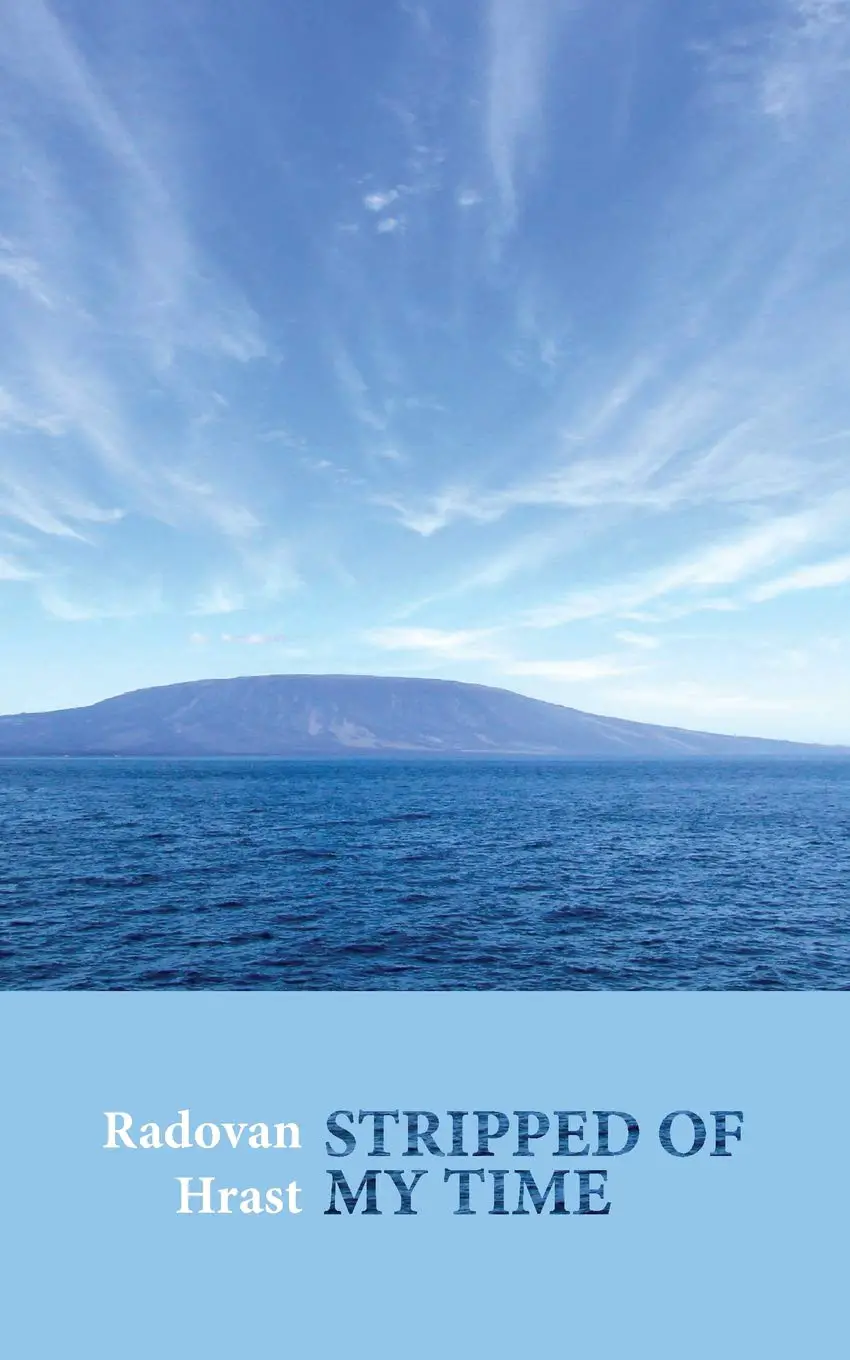
His darkest blot is surely Goli Otok, and this book is the definitive insider account of what life, if you can call it that, was like on the “Yugoslav Gulag.”
The author of a memoir, Stripped of My Time: A Survivor of the Communist Prison on Goli Otok, Radovan Hrast, contacted me in a most unusual way. He showed up at my front door, out of the blue, at the age of 85, after having read an article about me in some newspaper or other. As the only American writer and historian living as an expat in Slovenia, he saw in me someone who might help him give voice in an anglophone outlet to his story. His memoir was originally published decades ago in Slovenian, at first in a thick edition, and later in a more slender one. It is this more slender edition that you hold in your hands now, translated for the first time into English.
Radovan is a ray of sunshine. This is the first thought that strikes just about anyone who meets him. He is also now nearly 90, and the combination of being so peppy, bubbly and enthusiastic, cut with his advanced age, makes me want to know what is in his secret sauce. He is a man of great emotion and loyalty and deep thought, though set against his background, which he repeatedly describes as a life “without schooling.” What his prose may lack in grammatical consistencies and grace notes, it more than makes up for in honesty, detail, a razor-sharp memory and one heck of a story. Radovan’s main claim to fame is that he survived internment, twice, on Goli Otok.
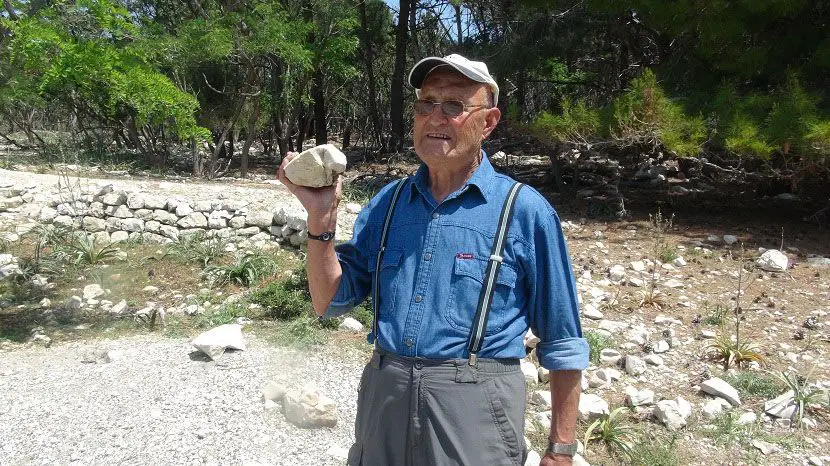
Radovan Hrast
Located just off the Dalmatian coast, Goli Otok was considered the harshest prison environment for Yugoslavs who were not toeing the line. It was almost exclusively for citizens who got into trouble (military officials, politicians, foreigners and women were imprisoned elsewhere). It was home to a bizarre but calculated series of rituals designed to make the fellow prisoners act as jailers, torturers and intimidator for their fellow inmates. There, prisoners were given no time to rest, no time to think, and were forced to attack one another on a daily basis, which had the effect of preventing possible bonding and conspiratorial attempts to escape. Radovan was one of the first inmates there, sent for a trifle while still a teenager. When he got out, he was double-crossed and sent back. Those sent for a second time were subject to an increasingly brutal regime, and it is a small miracle that Radovan survived. It is a giant miracle that he flourished and lived out the rest of his life as a happy, fulfilled person unaccompanied by what would be understand rage and the urge for vengeance.
This book should surely take its place on the shelves of every history library and make the reading list for all students of 20th century history and political science, especially those who deal with Yugoslavia and the aftermath of the Second World War. One would think that a man who lost years of his life unjustly would be bitter and vengeful and bear a broken spirit. Nothing of the sort. He is the most enthusiastic, kind and effervescent octogenarian one could imagine. I was delighted to guide him through the process of publishing his book, which I was certain that any good history press would snap up immediately. But because of his advanced age, understandably was wary about waiting the months to more than a year that it would take to shop for a press based on a book proposal, wait for acceptance, then work the many drafts with editor. Radovan does not know how to use a computer and has, of course, no email, so the logistics of dealing with a formal publisher were impossible. In the interests of time, I set him up with a great translator, a great designer and helped him to self-publish. His only goal is to make his story available as widely as possible. And now, here it is. We are grateful for the chance to preserve this story of horror and ultimate triumph of the human spirit.
Buy Stripped of My Time: A Survivor of the Communist Prison on Goli Otokon Amazon





